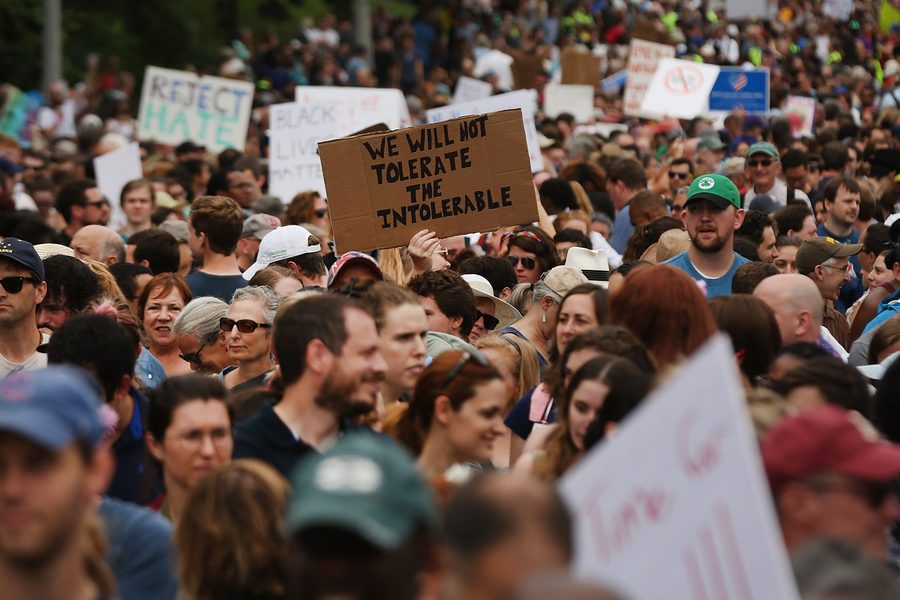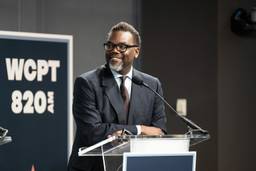Fascism in the United States Can’t Be Defeated Without a Mass Movement
A broad-front approach means drawing from a range of social movements—all those harmed by the reactionary right.
Shane Burley

The following is an excerpt from the book Fascism Today: What It Is and How to Fight It.
On the eve of Donald Trump’s inauguration, Mike Cernovich, the “MAGA Mind-set” internet celebrity, and Peter Thiel associate Jeff Giesea held the much-publicized Deploraball in Washington, D.C. — an event named as a campy throwback to Hillary Clinton’s unfortunate “basket of deplorables” quip about Trump supporters. The event was conceived of as a meeting of the “trolls,” a celebration of the culture that “meme’d [Trump] into the White House.” The ball lacked strong ideology and instead was a celebration of Twitter message boards, snarky graphics, and the ability to sway conversations through a mean-spirited, tech-savvy persistence. It was as if someone had taken the culture of the Alt Right and stripped out the hardline white nationalism, leaving only an internet culture of “anti-PC” web-warriors who would rather be right than white. Trolling, the ability to offend, is their politics, and people like Alt Light leaders like Richard Spencer and Nathan Damigo only side with that behavior if it can create a space for white identity politics.
Cernovich and Giesa, who had been running the pro-Trump MAGA3X organization, had become leaders in the Alt Light, the slightly more moderate allies of the Alt Right, with Cernovich, known for his right-leaning online self-help books, battling it out with Richard Spencer over who held the rights to the term “Alt Right.” While the Alt Right means white nationalism more than anything else, the Alt Light took a more “Civic Nationalist” approach and would have more in common with the “America First” nativism of Pat Buchanan than open neo-Nazis. The Deploraball was supposed to be a large Alt Light meet-up and did attract people like Neoreaction-friendly tech impresario Peter Thiel, but Breitbart antagonist Milo Yiannopoulos and conspiracy hero Alex Jones were notably absent, and Spencer had been banned outright in Cernovich’s effort to kick out explicit white nationalists.
Though it attracted a couple of hundred inside, it was the angry waves of antifascist protesters that completely overshadowed the event from the outside. Organized in part by Refuse Fascism, which had been organizing mass counter-actions in response to the Alt Right and the Trump inauguration, protesters dragged trashcans and newspaper dispensers into the street to block off the roads and taunted attendees. James O’Keefe, the Breitbart-allied sensationalist who staged videos to disgrace ACORN and Planned Parenthood, released videos of the D.C. Anti-Fascist Coalition who were planning direct actions during the inauguration and at the Deploraball. While the Alt Right and their coterie were in a period of jubilant celebration, their step forward was marked less by success and more by a wall of opposition.
In The Age of Trump
Two years earlier, no one as obscure as Cernovich could assemble hundreds of protesters, and even Richard Spencer was barely known as recently as 2014. But as the Alt Right entered the public arena, more traditional white supremacist organizations got a steroid injection. Trump inflated the racist subconscious of America, and the urgency of the situation fertilized the growing resistance. As Spencer alluded, there is a growing clash between the right and the left, yet those who are building a base against white nationalism are the dominant faction by far. With antifascist organizations reaching numbers not seen in years, the Alt Right became the catalyst for left opposition. This dialectic was a microcosm of the political polarization in the country as a whole. It was no longer the hardcore ideologues of Antifa organizations that were confronting the fascists, but regular people skewing to the left, and the concept of anti-fascism as a political program went from abstract to concrete as the threat of fascism became tangible. While the Alt Right intended to move the conversation to the right, they moved the left further left, and their weight pulled the Overton window back with them, thereby mainstreaming antifascism.
What does it mean when a minority movement, one meant to confront a marginal threat, moves from the edges to the mainstream? What happens when white supremacists shift from a threat of vigilante violence and radical co-optation to national political influence? As the enemy leaves the gate and the left’s numbers swell, the answer to confronting rising fascism lies in reframing the proposition of a “diversity of tactics” to see the complex patchwork that makes up mass movements as the coalescence of that diversity. The concept of “mass movement antifascism” implies a strategic choice, one that looks at all available options and finds the best possible route rather than an ideologically favored one.
As Trump entered his first week in office he tried to keep his promises about Muslim immigration, working with reactionary politicians like Rudy Giuliani to pass an executive order halting immigration from seven primarily Muslim countries. This created pandemonium in airports across the country as refugees were turned away, students and professionals were detained without access to attorneys, and LAX and JFK became holding pens for those who suddenly had their visas revoked. This order was met with some of the largest spontaneous protests in recent history, with airports all over the country overflowing with protesters. Public pressure, as well as a court order that overruled Trump’s decision, helped push through international travelers, and showed that Trump’s attempts to close the border would not only be opposed, but would also be openly defied.
Trump’s White House was stacked with all elements of the “respectable” far-right. Steve Bannon’s “American Nationalism” was met by controversial figure Steven Miller, who had an organizing relationship with Richard Spencer and anti-immigrant zealot Peter Brimelow in college and now acted as a stalwart against refugee resettlement and non-white immigration programs across the board. Sebastian Gorka rounded out the most controversial slate of appointees in years, eventually being outed for his relationship to an openly fascist and anti-Semitic Hungarian militia, the Hungarian Guard, and the “chivalrous” Order of Vitéz. After the election, Vice News producer Reid Cherlin described a 2014 attempt to write a story about an almost unheard of publication called Breitbart and the collection of far-right ideologues that populated their lively townhouse party, including Gorka, Bannon, Jeff Sessions, and Milo Yiannopoulos, as well as head of the nationalist U.K. Independence Party Nigel Farage. “At the time, if you had said this room was full of the most important future policy thinkers in America it would have just been so implausible. Because they were so fringe.”
An executive order like the travel ban may not have inspired such quick and decisive action in the pre-Trump era or without the specter of advisors he was amassing, but as the Alt Right grew and America’s racism became more explicit, a culture of resistance quickly matured. In Trump’s America, there is bigotry and state violence, and there is also a passionate movement to support the most marginalized, to live up to the phrase “Never Again.” The mass turn toward antifascism comes from a culture ready for resistance, a culture ready to bring protest to a scale necessary when the state is friendly to or occupied by a fascist movement.
A History of Resistance
The lessons of the past loom heavily on the development of a mass antifascist movement, including the lineage of organizations, both in the United States and internationally, that have been doing this work in various capacities for decades. While antifascism has a direct continuity from before the Second World War to the present day, making the streets of London a cauldron of confrontation between the British Union of Fascists and 43 Group, Combat 18 with Anti-Fascist Action. The United States also has a unique history. There is a tendency to delineate between liberal and militant antifascism, but we can broadly define movements by highlighting their purpose. The purpose of antifascism is a complete repudiation of fascism and its removal from the culture. The point is not that there is no tactical difference, or even that liberal approaches have often reinforced the state and undermined effective challenges to fascist growth, but that the boundaries that are outlined are fuzzier and more easily redrawn than we have thought. While direct confrontation is never off the table, not all organizers approach every situation in that fashion. Instead a new antifascist ethos may be taking hold, one that sees multiple approaches as valid, as they are all matched by the same motivating impulse: fascism is to be ended, not debated.
What may be different in this shift to a mass movement is the willingness to put a public face to antifascist organizing, to operate in plain sight. Security has always been paramount in many areas of antifascist organizing, which brings benefits as well as challenges for scaling up a movement’s size. Achieving mass involvement — with participants of varying commitment levels and skillsets — requires recruitment, public information, and a certain level of openness. How this plays out now will depend on existing organizations, how they relate to each other, and how public they can be given the violent revenge often sought by insurrectionary racists. Coalition efforts have often provided the answer to this. In coalitions, various groups take up different components of a particular project or committees that can determine exactly what degree of public profile are necessary for the job.
A mass movement approach means drawing from a range of social movements — conceivably, all those touched by the reactionary right — each with their own political trajectory and history of gains and losses. The structures of different resistance, from organized labor to the tenants’ movement erupting in America’s urban core, provide structural lessons for confronting the far-right in the halls of power and the creeping white nationalism all around. The revolutionary white nationalist current, led by the Alt Right, has begun creating strong institutions from media outlets to regional cadre organizations bent on seeing material gains through wedge issues. This shift creates the opportunity to borrow from the strategies that the left has used over a long history of struggle.
The current, more public nature of the white nationalist movement means that formalized campaigns against them can grow, and they can have a layer of organizers and an outside ring of supporters who rely on public communication. This allows for a range of tactics including escalation campaigns, boycotts, mass mobilizations, building occupations, and so on. “Community organizing” is stripped down to its bare essentials and reframed to target fascist threats. The tactics of community unionism, hailing from the early syndicates of the shop floor and brought into the neighborhoods through tenant resistance, provides a range of solutions, such as defending both against white supremacist violence as well as protecting undocumented people against the impending ICE raids of Trump’s fantasies. The model here is less to replicate the blueprint of successful antifascist movements of the past than to use the entire toolkit of revolutionary organizing. During the civil rights movement that resisted Jim Crow from the 1950s to the ’70s, the battle against both the insurrectionary advances of the Klan and the embedded white supremacy of the apartheid state ran parallel, and the successes depended on the ability to expand involvement while adopting tactics and strategies that worked in each particular venue.
Any successful social movement allows for diversity in roles, matching the different personalities, interests, and skills of the actors, creating a patchwork that reflects the constituents as much as the goals. Movements developing today that seek to stop the growth of the far-right are moving toward an inclusionary framework that makes mass movements work: they have different tasks for different people. How this is structured pragmatically can and should depend on the people involved, how they work best, and what the unique situation is of a given area. For people forming new groups, a broad-based community strategy requires external communication, educational and community-building events, campaign planning, public actions, research and information dissemination, and all the other component parts. Many antifascist organizations previously ran on tight, information-restricted formulas, yet this could limit their ability to expand beyond a close-knit cadre of committed organizers, and would also preclude most people from participating. What movements in this new climate will grapple with is how to best make use of every interested person in relation to the larger organizing goals, which means that a fully realized antifascist movement will have different types of campaigns, multiple approaches, and a complex web of support systems. The challenge will be to make these facets work with one another rather than creating conflicts.
Shane Burley is a journalist and filmmaker based in Portland, Oregon. He is the author, co-author, and editor of four books, including Safety Through Solidarity: A Radical Guide to Fighting Antisemitism (Melville House, 2024) and Fascism Today: What It Is and How to End It (AK Press, 2017). His work has been featured in NBC News, Al Jazeera, Jewish Currents, The Daily Beast, Jacobin, The Baffler, Yes! magazine and the Oregon Historical Quarterly. Follow him on Twitter @shane_burley1 and Instagram @shaneburley.








